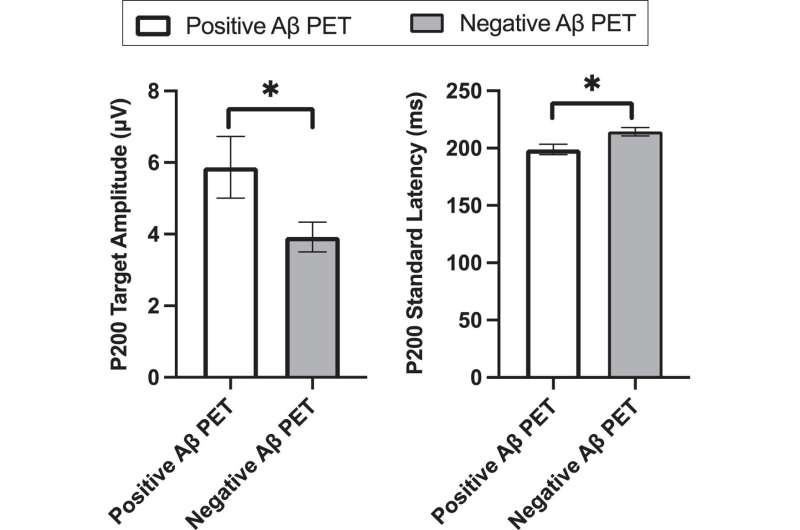This article has been reviewed according to Science X's editorial process and policies. Editors have highlighted the following attributes while ensuring the content's credibility:
fact-checked
peer-reviewed publication
trusted source
proofread
Study validates diagnostic tool for identifying amyloid beta plaques, the hallmark of Alzheimer's disease

Amyloid PET scans provide in-vivo evidence of Alzheimer's disease (AD) pathology. However, due to their high cost and limited insurance coverage, they are not widely used in clinical settings outside of the VA Healthcare System. A special form of electroencephalograms (a test that measures electrical activity in the brain) referred to as event-related potentials (ERPs), measures electrical activity that reflects both sensory and cognitive responses to stimuli.
A new study from researchers at Boston University Chobanian & Avedisian School of Medicine and the Icahn School of Medicine at Mount Sinai has found that ERPs are helpful in diagnosing AD in a clinical setting and may be potentially useful as a disease biomarker. This is the first study to explore the utility of ERPs as in-vivo biomarkers of AD in a diverse group of patients in a real-world clinical setting.
The findings are published in the Journal of Alzheimer's Disease.
"ERPs are an inexpensive and non-invasive method of measuring brain function that may support the detection of AD pathology in-vivo and thus help gauge the presence of neurodegenerative processes," explained senior author Andrew Budson, MD, professor of neurology at the school and chief of cognitive & behavioral neurology at the VA Boston Healthcare System.
Veterans aged 50 to 100, from the memory disorders clinic at the VA Boston Healthcare System, had an amyloid PET scan as part of their usual clinical care to assess amyloid deposition, a key biomarker of AD pathology. Twenty-eight patients had a positive amyloid PET scan result consistent with AD, while thirty-nine had a negative result that showed they had a non-AD process causing their cognitive impairment. All participants underwent a neuropsychological evaluation (paper and pencil testing of their memory) and underwent an ERP session.
According to the researchers, the use of ERPs could help improve the current diagnostic practices in a memory clinic, which at the time of the initial visit relies heavily upon the collection of neuropsychological testing measures.
"ERPs may be a useful additional clinical tool to help determine whether patients should undergo more invasive biomarker techniques to confirm amyloid beta positivity," added co-first author Katherine Turk, MD, assistant professor of neurology at the school.
The researchers believe future studies should focus on whether ERPs are useful for monitoring response to anti-amyloid treatments in AD.
Anna Marin, Ph.D., post-doctoral fellow in the Department of Neurology at the Icahn School of Medicine at Mount Sinai, is the corresponding author. She is a recent graduate of the BU behavioral neuroscience Ph.D. program. This research was part of her dissertation.
More information: Anna Marin et al, The Use of Event Related Potentials to Predict Amyloid PET Status Among Patients from a Memory Disorders Clinic, Journal of Alzheimer's Disease (2024). DOI: 10.3233/JAD-231038




















